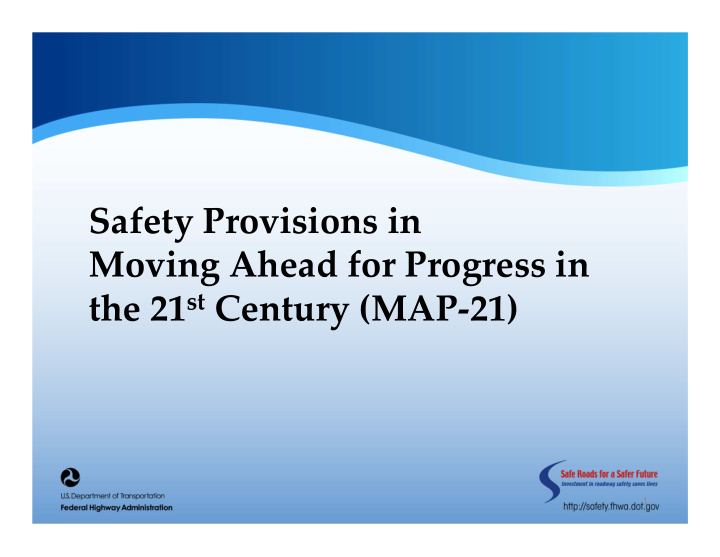



Safety Provisions in Moving Ahead for Progress in the 21 st Century (MAP ‐ 21) 1
MAJOR THEMES • Strengthens America’s highway & public transportation systems • Establishes a performance ‐ based Federal program • Creates jobs & supports economic growth • Supports the Department’s aggressive safety agenda • Simplifies and focuses the Federal program • Accelerates project delivery & promotes innovation
Highway Safety Improvement Program ($2.4B) Dramatically increases size of existing program • Maintains current structure; adds requirement for regular • update of the strategic highway safety plan Keeps setaside ($220M/year) for rail ‐ highway grade crossings • No high risk rural roads setaside unless safety statistics worsen • Secretary to establish measures and States to set targets for • number of injuries and fatalities (and number per VMT) Strengthens link between HSIP and NHTSA programs • 3
State HSIP • Advance the capabilities of the State for safety data collection, analysis and integration in a manner that complements State highway safety program and commercial vehicle safety plan • Use that safety data system to perform safety problem identification and countermeasure analysis – Identify hazardous locations, sections, and elements – Establish relative severity of those locations – Identify number of fatalities and serious injuries on all public roads by location in State – Consider which projects maximize opportunities to advance safety 4
State HSIP (cont.) • Adopt strategic and performance ‐ based goals that – address traffic safety, including behavioral and infrastructure problems and opportunities on all public roads – focus resources on areas of greatest need – are coordinated with other State highway safety programs • Determine priorities – Establish and implement a schedule of highway safety improvement projects • Establish an evaluation process • Driven by Strategic Highway Safety Plan 5
Strategic Highway Safety Plan (SHSP) • Requires regular updates – Secretary to set schedule and content of updated SHSP by October 1, 2013 • Expands list of participants – County transportation officials – State representatives of non ‐ motorized users – Other major Federal, State, tribal, and local safety stakeholders • Highway Safety Plan (NHTSA) coordinated with SHSP 6
Highway Safety Improvement Project • Strategies, activities, and projects on a public road that are consistent with a State strategic highway safety plan and – correct or improve a hazardous road location or feature; or – address a highway safety problem • Funds may be obligated to carry out any highway safety improvement project on any public road or publicly owned bicycle or pedestrian pathway or trail • List of examples included in MAP ‐ 21 7
Data Improvement • Activities – Highway basemap of all public roads – Collect safety data – Store and maintain safety data – Develop analytical processes for safety data elements – Roadway safety analysis tools – Analytical use of safety data • Model Inventory of Roadway Elements – Secretary shall – establish a subset of model inventory of roadway elements that are useful for inventory of roadway safety – ensure that States adopt and use subset to improve data collection 8
Coordination with NHTSA Programs • Ensure the State coordinates the Highway Safety Plan (HSP) w/the State Strategic Highway Safety Plan (SHSP) • Ensure the State coordinates data collection and information systems with the State SHSP • Aligns performance measures for SHSP and HSP 9
Safety Performance Management • MAP ‐ 21 identifies Safety as a national goal area • USDOT establishes measures by April 2014 – Serious injuries and fatalities per vehicle mile traveled (VMT) – Number of serious injuries and fatalities • States set targets 1 year after measures established – Can adjust targets for urban or rural areas • State & metro plans describe how programs and projects will achieve targets • If a State has not met or made significant progress toward meeting safety targets in 2 years – Obligation authority equal to prior year HSIP apportionment only for HSIP projects – Annual safety implementation plan describing actions State will take to meet targets 10
Safety Performance Management (con’t) • High ‐ Risk Rural Road Safety: If fatality rate on rural roads increases over 2 ‐ year period, State must obligate for projects on HRRRs at least 200% of FY09 HRRR program • Older Drivers: If fatalities and serious injuries per capita for road users over 65 increases during 2 ‐ year period, must include strategies in subsequent SHSP, considering Older Driver Handbook recommendations 11
Study of High ‐ Risk Rural Roads Best Practices • Report by October 1, 2013 – Literature review – Survey of current practice of DOTs and local units of government • Best Practices Manual 180 days after report – Include list of cost ‐ effective roadway safety infrastructure improvements and best practices – Use of manual shall be voluntary 12
Other Safety Programs • Safe Routes to Schools – Eligible as part of Transportation Alternatives program • Railway Highway Grade Crossing Program – Set ‐ aside still $220M (~9% of total HSIP) • Puerto Rico highways (continued; $150M/yr) – ≥ 25% must be used for HSIP projects • Tribal Transportation Program – 2% set aside for safety on tribal land 13
Questions?
Recommend
More recommend